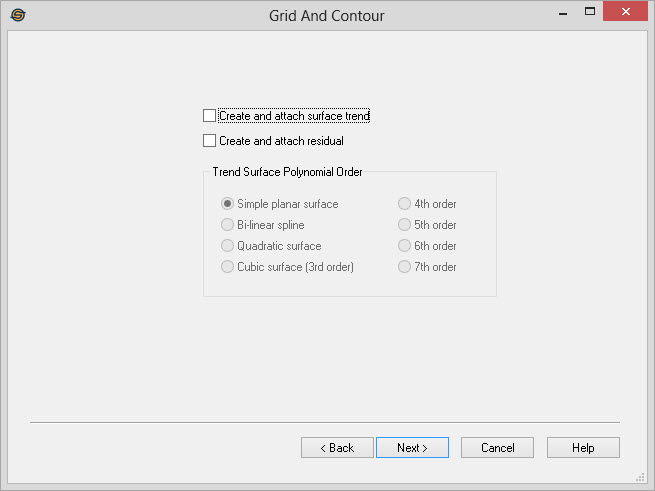Grid and Contour: Trends and Residuals
Select whether to create a trend surface and/or a residual.

Create and Attach Surface Trend
This option creates a trend surface. The trend surface is calculated
using a polynomial regression algorithm to create a smooth surface that
approximates the seed points. The higher the order of the polynomial
used, the more closely the trend surface will match the seed points.
Create and Attach Residual
A residual surface is the difference between the trend surface and the gridded surface. The residual surface can show anomalies between the gridded surface and the trend surface.
Trend Surface
Polynomial Order: The order of the polynomial that will be
used in generating the trend
surface. The higher the order, the more closely the trend
surface will match the seed points. Also, the higher the order, the
longer it will take to calculate the trend surface.
- Simple Planar Surface: Creates the residual surface using the function z(x,y) = A + Bx + Cy
- Bi-linear Spline: Creates the residual surface using the function z(x,y) = A + Bx + Cy + Dxy
- Quadratic Surface: Creates the residual surface using the function z(x,y) = A + Bx + Cy + Dx2 + Exy + Fy2
- Cubic Surface: Creates the residual surface using the function z(x,y) = A + Bx + Cy + Dx2 + Exy + Fy2 + Gx3 + Hx2y + Ixy2 + Jy3
- 4th Order: Creates the residual surface using the function z(x,y) = A + Bx + Cy + Dx2 + Exy + Fy2 + Gx3 + Hx2y + Ixy2 + Jy3 + Kx4 + Lx3y + Mx2y2 + Nxy3 + Oy4
- 5th Order: Similar to the above 4th order
- 6th Order: Similar to the above 4th order
- 7th Order: Similar to the above 4th order
Grid and Contour Wizard Options
— MORE INFORMATION

|
Copyright © 2020 | SeisWare International Inc. | All rights reserved |